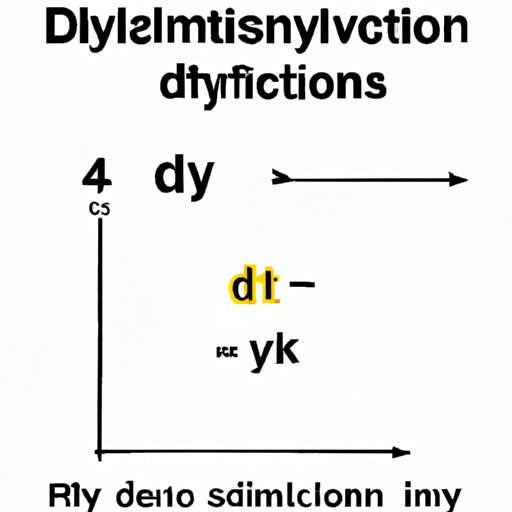
I. Introduction
When it comes to solving algebraic equations, synthetic division is an important tool to have in your arsenal. But what exactly is synthetic division? In essence, it’s a shortcut method of dividing a polynomial by one of its linear factors. Understanding this process can make solving equations simpler and more straightforward.
II. A Step-by-Step Guide to Synthetic Division: Solving Algebraic Equations Made Easy
The process of synthetic division can be broken down into clear steps. To start, the linear factor is written in the form (x – a), where a is a constant. Next, the coefficients of the polynomial term are written in a row. The first step is to bring down the leading coefficient, then to multiply that number by the constant term a. The resulting number is added to the next coefficient, and the process continues until all coefficients have been processed.
Let’s walk through an example: (x^2 + 4x – 3) / (x – 2). First, we write (x – 2) in the form (x – a), where a is 2. Next, we write the coefficients of the polynomial: 1, 4, -3. We bring down the first coefficient (1), multiply it by 2 to get 2, and add it to the next coefficient (4) to get 6. We repeat this process until all coefficients have been processed:
(x^2 + 4x – 3) / (x – 2) = x + 6 + 9 / (x – 2)
This is the final representation of the equation. Essentially, the quotient is x + 6 and the remainder is 9/(x-2).
III. Mastering Synthetic Division: Tips and Tricks for Faster, More Accurate Calculations
As with any mathematical process, there are ways to streamline the synthetic division process and avoid common mistakes. One helpful tip is to always double-check the linear factor (x – a) to ensure it’s written in the proper form. Additionally, it’s important to ensure all coefficients are written in the proper order before beginning. Another useful technique is to eliminate any unnecessary steps in the calculation process by mentally combining numbers or breaking them down into simpler terms.
IV. The Mathematics of Synthetic Division: A Deep Dive into Theory
While the previous sections have focused on the practical application of synthetic division, it’s worth delving a bit deeper into the mathematical theory behind it. Specifically, the process of synthetic division is based on the idea that any polynomial function can be factored into linear and quadratic terms. Synthetic division can be used to remove the linear terms, leaving only the quadratic terms, thus simplifying the equation so that the remaining roots can be more easily identified. Additional strategies involve simplifying the process of long division, which can be a tedious and time-consuming process.
V. A Beginner’s Guide to Synthetic Division for Algebra Students
For students just getting started with algebra, synthetic division can seem like a daunting subject. However, with careful explanation and plenty of practice problems, it’s possible to master this technique. One effective way to help students grasp synthetic division is to provide real-life examples of how it can be used, such as in engineering projects or statistical analysis.
It’s also helpful to introduce key terms and concepts, such as the linear factor and the remainder theorem. By building a strong foundation of basic knowledge, students can feel more confident applying these concepts in more complex equations.
VI. Cracking the Code of Synthetic Division: How to Solve Complex Polynomials
Once you’ve mastered the basics of synthetic division, it’s important to learn how to apply these concepts to more complex equations. One technique for tackling more challenging problems is to begin by factoring the polynomial as much as possible to simplify the equation. Then, you can apply synthetic division to the remaining factors to further simplify the problem.
Another helpful strategy is to work through each step of the synthetic division process slowly and methodically, double-checking each answer before moving on to avoid mistakes. In some cases, it may be helpful to use a calculator to double-check arithmetic, particularly when dealing with large or complex numbers.
VII. Why Synthetic Division Matters: Real-World Applications of Algebra
While synthetic division may seem like an abstract concept with little real-world relevance, it’s actually an important tool in a variety of fields. In engineering, for example, synthetic division can be used to analyze and optimize complex systems. In statistics, it can help researchers identify patterns and relationships in large data sets. And in economics, it’s used to model and understand the behavior of markets and economies.
Overall, a strong understanding of synthetic division is an important foundation for success in a variety of fields.
VIII. Synthetic Division 101: Everything You Need to Know in One Comprehensive Guide
To summarize all of the above information, a comprehensive guide to synthetic division should cover everything from the basics to more advanced techniques, with an eye towards real-world applications and practical problem-solving. In addition to a step-by-step breakdown of the process, such a guide might include example problems with detailed explanations, tips and tricks for speeding up calculations, and a more technical exploration of the underlying mathematical theories.
IX. Conclusion
While mastering synthetic division may seem difficult at first, with practice and dedication it’s possible to become comfortable with this fundamental algebraic technique. Not only can synthetic division simplify the process of solving equations, it’s also an important foundational tool for success in many different fields. Whether you’re just starting out in algebra or looking to refresh your skills, synthetic division is an essential subject to understand.




